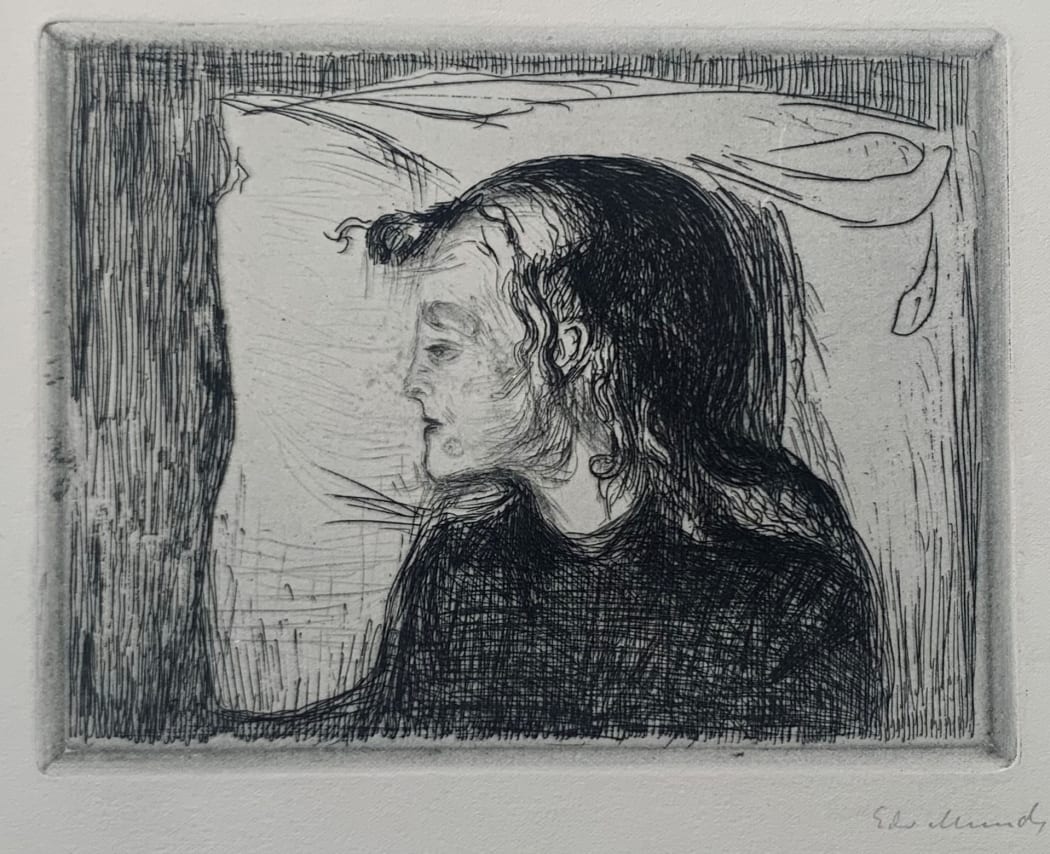
A couple of weeks ago, we looked together at Edvard Munch’s much revisited Das Kranke Kind, or, The Sick Child. Specifically, we studied W7, a drypoint iteration of the motif created in 1894. I said that it was one of my favorites because it is quintessentially Munch – an image that he seemed to have stuck in his head, one that he played out in paint, in drypoint, and, as we’ll learn today, in etching and lithography. It is an image that reads more as the surreal truth of his memory than as biography. Munch himself agreed with its importance: “In The Sick Child I opened for myself a new path,” he wrote in his journals. “It was a breakthrough in my art. Most of what I have done since had its birth in this picture.”*
Munch was more a wordsmith than he is often given credit for, for how poetic (if not a bit pathological) to pose the creation of all of his most important works at the deathbed of his beloved sister. In case you missed the history of the image in our previous mailing (which you can read here), I’ll remind you of Munch’s story: As a boy, he lost his mother to tuberculosis; he suffered from the same disease, missing a good deal of his childhood education. Not long after that, his older sister Sophie, his most beloved relative and the one who had assumed the role of caretaker, also succumbed to it. Munch was left with younger siblings and a father who prioritized his relationship with God over that of his children.

Det syke barn I (The Sick Child I) (Woll 72), 1896, lithograph, 16 5/8 x 22 1/2 inches
So, inescapable in Munch’s vision of his own fledgling autonomy, there was always Sophie lying wanly in her bed. In W59, the etching pictured above, she gazes off to the left of her pillow. Her hair has thinned; her lips are parched; her eyes are unfocused. Her entire face appears shrunken. The depth created on the copper plate adds a morose, ghostly affect. In W72, a lithograph, Munch did more than change his technical approach. Here, Sophie has turned her head to gaze out to the right. There is a highlight on her pillow like the sun streaming through a window. Though she’s managed to open her eyes, perhaps to look out on a sunny morning – maybe her last – they are dark with an exhaustion incurable by sleep. There is a very soft yellow tinge to the lighter areas of the paper, reinforcing the sickly feeling. You’ll recall that in the drypoint W7, we got the whole scene – Sophie and the Munch’s aunt clutching fingertips, everything hatched and hazy except for Sophie’s stark white face. In all of his iterations, Munch never figured Sophie sitting or looking exactly the same way. That’s because these works are not the fruit of a perfectionist’s attempts to render the moment just right; these are memorials. These are manifestations of what Munch saw, standing in the doorway or above his sister’s bed. These are the tossings and turnings of children confronting death.
And finally, the last answer I’ll surrender (for now) on my personal Munch and Picasso through line, the answer to the question, “Why those two?” Gerd Woll, former Senior Curator at the Munch-museet in Oslo and famous cataloguer of his works (indeed the namesake of the W’s listed above), said this: “From the first years, the criticism of Munch was that he didn't finish his [artworks], they were sketches and starts. This was true, if you compare them to paintings in the Salon. But he wanted them to look unfinished. He wanted them to be raw and rough, and not smooth and shiny.”** Down to the bit about rebellion against the normative art world, Ms. Woll might as well have been referencing Picasso. Both artists were more interested in the why, the how, than the what; they were more interested in a reality sculpted by emotion, pure perception, than one teachable in a drawing class.
Looking forward to where Munch and Picasso will take us next week. Until then, wishing you a safe and restful weekend.
